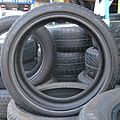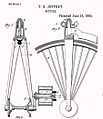Tire facts for kids
A tire (or tyre in British English) is a strong ring of material that fits around the rim of a wheel. Most cars, trucks, and many other vehicles use tires made of rubber. Tires help vehicles move smoothly and safely on the road. Some metro trains and trams even use rubber tires on their steel wheels. This helps them get better grip than trains with only steel wheels.
It's important to change tires when their treads wear out. Driving with worn-out tires can be very dangerous. It might cause a tire to burst or make it hard for the driver to control the vehicle.
Contents
How Are Tires Made?
Tires are made from different kinds of rubber. The type of rubber used depends on what the tire is for. For example, softer rubber is used for summer driving or for auto racing. This gives better grip, also known as traction.
Tires made of harder rubber last longer. They are often used for vehicles that travel long distances, like big trucks. Tires come in many different sizes and have unique patterns on their surface called treads.
Understanding Tire Sizes
You can find the size of a car or truck tire marked on its side. It usually looks like three numbers, for example: 225/60R16.
- The first number (like 225) tells you the width of the tire in millimeters. This is the widest part when the tire is on the wheel and filled with air.
- The second number (like 60) is a percentage. It shows how tall the sidewall (the side of the tire) is compared to its width. So, 60 means the sidewall height is 60% of the tire's width.
- The last number (like 16) tells you the diameter of the wheel in inches.
Let's look at an example:
- Tire size: 225/60R16
- Tire width = 225 millimeters
- Sidewall height = 135 millimeters (because 225 * 0.60 = 135)
- Wheel diameter = 16 inches
Very large tires, like those on huge mining trucks, use a slightly different way to show their size. For example, 59/80R63. Here, the first number is the width in inches, and the last number is still the wheel diameter in inches.
What Happens When a Tire Gets Damaged?
Most modern tires do not have an inner tube. Instead, they are designed to seal tightly onto the wheel. This allows them to hold a lot of air pressure.
If a tire gets a crack or a hole, it can't hold air anymore. This is called a tire leak. Leaks are quite common. Often, a nail or screw can cause a small hole. If the hole is in the main part of the tire, it can usually be fixed. A special patch is put on the inside to seal the hole.
However, if the hole is near or on the side of the tire, it usually cannot be fixed. This is because the sides of the tire bend and flex a lot to support the vehicle's weight. A patch would not be strong enough to handle this movement and would likely fail.
Tires for Different Weather
Many tires are designed for specific weather conditions.
Mud and Snow Tires
You might see "M+S" or "M&S" marked on some tires. This stands for Mud and Snow. These tires are made for all-season or winter driving. They are designed to work better in cold weather than regular summer tires.
The rubber in M+S tires is usually softer. This helps them grip better on ice and snow. However, this softer rubber wears out faster in warmer temperatures. These tires often have many small cuts in their tread pattern, called sipes. These sipes help the tire grip icy surfaces. M&S tires are often standard on four-wheel drive vehicles.
Images for kids
-
Tire cross section showing components.
-
NASCAR tires
-
Changing a wheel on a Lockheed P-3 Orion aircraft.
-
Tires on the wheels of a Boeing 777.
See also
 In Spanish: Neumático para niños
In Spanish: Neumático para niños























